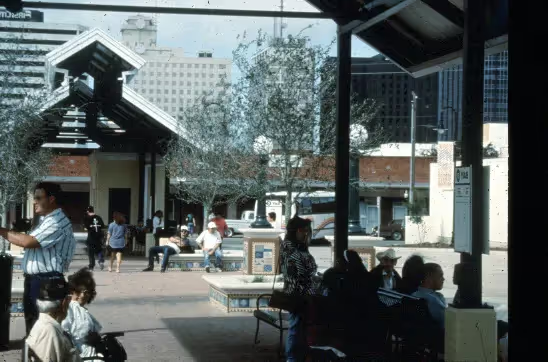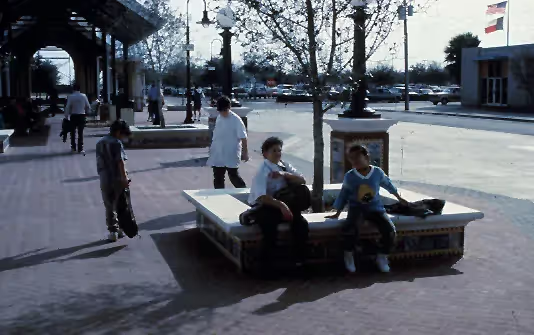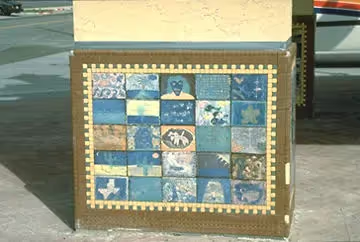A biweekly newsletter with public space news, resources, and opportunities.
A curated dispatch on all things public markets plus the latest announcements from the Market Cities Program.
Please note that these Hall of Shame nominations were written in a moment in time (most over a decade ago) and likely have since changed or even been transformed. If the above entry is now great, or still not so great, go ahead and comment below on how it has evolved or nominate it as a great place.

By making people-friendly improvements, this place - serving up to 5,000 users daily - went beyond the typical transit center and is helping reshape the surrounding community.

The front of the station, which serves 14 bus routes and some 5,000 transit users per day, resembles a Spanish-style civic building; in the back, high metal roofs supported on steel columns mimic the feel of a 19th-century train shed. 1500 hand-painted ceramic tiles produced through a public art project decorate the entry arch, column bases, benches, planters, light fixtures and phone booths. At the station's heart is an open space surrounded by trees in tiled planters, designed as a focal point for vending or a fountain.
Corpus Christi's Regional Transportation Authority (RTA) found that by making people-friendly improvements to such transit centers, it is able to reach beyond the boundaries of building typical bus stops to the larger goal of helping to reshape communities. The Staples Street station brings more passengers to the area, thereby encouraging economic activity. Inside, it provides enhanced passenger services, greater comfort, and a sense of safety and community among users and staff, as well as further opportunities for retail development.
The Staples Street Bus Station was well-received throughout the city, and acclaimed around the U.S. as the embodiment of a groundbreaking approach to the design of transit facilities.
The station is across the street from City Hall.
Large number of transit users at this place make it safer and more secure than typical bus stops. Trees, artwork, and architectural forms make it a pleasant place, though the atmosphere could be enhanced with food and beverage carts, cafes, or other retail opportunities surrounding the station, and simple entertainment. Main complaints expressed by transit users were inadequacy shelter during heavy rain and wind, and a lack of restrooms.
Ridership increased notably with the consolidation of area bus stops at this one station. The station design allows for small retail uses to be accommodated on site: retail kiosks within the walls in front, and vending carts in the open space. These opportunities have not been taken advantage of, though they're under consideration. The surrounding area could also use more restaurants and retail to serve the large numbers of riders congregating here.
The new bus transfer center has become almost a town square or plaza not only because of the number of people who are compelled to pass through it, but also since it attracts other people who simply come there to "hang out." Transit users know that they will encounter friends and acquaintances there and even meet new people, as they wait for their buses. In the afternoon, when the largest numbers of people are present, the station has a festive feeling about it, with people socializing and meeting friends. Bus drivers waiting for their riders appear to be well-known by passengers and often greet them, chatting with their colleagues as well.
The Staples Street City Hall bus transfer center opened in February 1994. Project for Public Spaces received a Federal Design Achievement Award for its work on this station, as part of the National Endowment for the Arts Presidential Design Awards Program.
Community involvement, both in terms of developing the design as well as in actual participation in the project, was deemed critical to the Staples Street Station's success. It was one of a series of projects to streets/transit facility improvement projects that PPS did in conjunction with the Corpus Christi Regional Transportation Authority from 1991 to 1996. Community workshops served to develop innovative enhancements for trolley and bus stops, the City Hall bus transfer center, and streetscapes. Plans included newsstands, plants, vending facilities and carts, an arcade facade along a retail area, angled parking in suitable areas, and public sculpture.
The RTA's transit center-based approach is designed to supplement, or even replace bus stops along corridors. Through rescheduling, the RTA brought as many as 14 routes together, thus congregating large numbers of transit users and necessitating a larger facility than a simple bus stop - and thus potentially creating new nodes of retail or other activity, as well as pleasant waiting places.
The Corpus Christi RTA and its capital improvements are funded by a 1/2 percent sales tax. A Federal Transit Administration grant of $800,00 was utilized for the completion of the Staples Street Station. FTA Livable Communities funding is being used for pedestrian improvements to existing transit centers.






*Please note that these Hall of Shame nominations were written in a moment in time (most over a decade ago) and likely have since changed or even been transformed. If the above entry is now great, or still not so great, go ahead and comment below on how it has evolved or nominate it as a great place.